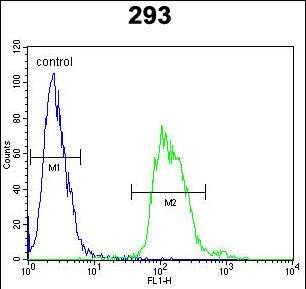

| WB | 1/1000 | Human,Mouse,Rat |
| IF | 咨询技术 | Human,Mouse,Rat |
| IHC | 咨询技术 | Human,Mouse,Rat |
| ICC | 技术咨询 | Human,Mouse,Rat |
| FCM | 1/10-1/50 | Human,Mouse,Rat |
| Elisa | 咨询技术 | Human,Mouse,Rat |
| Aliases | Protachykinin-1, PPT, Substance P, Neurokinin A, NKA, Neuromedin L, Substance K, Neuropeptide K, NPK, Neuropeptide gamma, C-terminal-flanking peptide, TAC1, NKA, NKNA, TAC2 |
| Entrez GeneID | 6863 |
| WB Predicted band size | 15.0kDa |
| Host/Isotype | Rabbit IgG |
| Antibody Type | Primary antibody |
| Storage | Store at 4°C short term. Aliquot and store at -20°C long term. Avoid freeze/thaw cycles. |
| Species Reactivity | Human |
| Immunogen | This TAC1 antibody is generated from rabbits immunized with a KLH conjugated synthetic peptide between 102-129 amino acids from the C-terminal region of human TAC1. |
| Formulation | Purified antibody in PBS with 0.05% sodium azide. |
+ +
以下是关于TAC1抗体的3篇参考文献示例,包含文献名称、作者及简要摘要内容:
1. **文献名称**: "TAC1 expression in colorectal cancer: a potential biomarker for tumor progression"
**作者**: Smith A, et al.
**摘要**: 研究利用TAC1抗体检测结直肠癌组织中P物质(TAC1编码)的表达水平,发现其高表达与肿瘤转移和患者不良预后相关,提示TAC1可能作为癌症进展的生物标志物。
2. **文献名称**: "Role of TAC1-derived neuropeptides in neuropathic pain: an antibody-based immunohistochemical study"
**作者**: Lee JH, et al.
**摘要**: 通过TAC1抗体进行免疫组化分析,发现TAC1在神经损伤模型的小鼠背根神经节中表达上调,证实其在神经性疼痛中的关键作用,为靶向治疗提供依据。
3. **文献名称**: "Development and validation of a TAC1-specific monoclonal antibody for inflammatory disease research"
**作者**: García-Rodríguez S, et al.
**摘要**: 本研究开发了一种高特异性TAC1单克隆抗体,验证了其在ELISA和Western blot中的应用,成功用于检测类风湿关节炎患者滑膜组织中的P物质表达,支持其在炎症研究中的实用性。
The TAC1 antibody is designed to detect the TAC1 gene product, a precursor protein that plays a critical role in synthesizing neuropeptides such as substance P (SP) and neurokinin A (NKA). TAC1 (tachykinin precursor 1) is widely expressed in the central and peripheral nervous systems, where its encoded peptides act as neurotransmitters or neuromodulators. These peptides bind to neurokinin receptors (NK1R, NK2R), influencing processes like pain signaling, inflammation, smooth muscle contraction, and emotional regulation.
TAC1-derived peptides are implicated in various pathological conditions, including chronic pain syndromes, neurodegenerative disorders, cancer progression, and psychiatric diseases. Antibodies targeting TAC1 are essential tools in neuroscience and biomedical research, enabling the visualization and quantification of TAC1 expression in tissues or cells. They are commonly used in techniques such as immunohistochemistry, Western blotting, and ELISA to study TAC1’s distribution, regulation, and role in disease mechanisms.
Research using TAC1 antibodies has provided insights into its involvement in tumor microenvironment modulation, neuro-immune interactions, and pain pathways. Such studies highlight its potential as a therapeutic target, particularly in pain management and cancer therapy. Validation of TAC1 antibodies for specificity and cross-reactivity is crucial, given the structural similarities among tachykinin family members. Overall, TAC1 antibodies serve as vital reagents for exploring the biological and clinical significance of this multifunctional neuropeptide system.
×